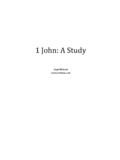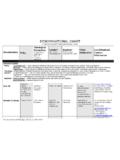Transcription of In His Image: A Study of the Image of God in Man
1 In His Image : A Study of the Image of God in Man By Angel Richard 2. Contents Introduction 3. Lesson One - Image Created, Part 1 4. Lesson Two - Image Created, Part 2 10. Lesson Three - Image Distorted 15. Lesson Four - Image Redeemed 21. Lesson Five - Image Restored 25. Appendix Bibliography & Suggested Reading 29. Chart 30. Confessional Resources 31. 3. Introduction My two older boys enjoy building Legos. The oldest one I would call a Lego maniac. One thing I have learned from them is that you cannot build a creation without first dumping out the pieces on the floor. That which seems disconnected through carefully placed precision becomes a beautiful, inspiring creation. The process of Lego building is the background for how I arranged each lesson. You will find that there are three divisions within the lessons: Gathering the Pieces, Building our Understanding, and Looking at the Implications. As I was considering the question of how to write a theological Study that anyone could use, the boy's favorite pastime seemed like a helpful format.
2 Within the category of Gathering the Pieces I used Richard Pratt's triangle Exegesis (Bible Study ), Community (Present and Past), and Private/Personal Judgment to frame out the pieces that were included to make the Study . Private or personal judgment actually falls in the category of Looking at the Implications.. So, when you begin Lesson One you will see elements of Bible Study alongside readings gathered from creeds and quotes from theologians. Creeds are documents that have been written in an effort to summarize what the Bible teaches regarding various topics or questions. They have proven helpful to me in knowing what the church fathers throughout history have said about man being created in the Image of God. They are part of understanding our past community. The theologians I selected represent more of our present community of believers who are thinking these issues through in our day. The categories introduced in Lesson One by John Frame that are credited to Meredith Cline's work are used primarily because they brought a simplicity and fluidity to the Study as a whole and are only offered as one way of looking at the Doctrine of the Image of Man.
3 If they prove helpful to you then use them if not, then feel free to look at the topic from another angle. I had considered looking at Lessons 1, and 3-5 with the categories relationship with God, the world, and others. It seemed that it might be interesting to Study what happens with the Image of God in man from creation to the return of Christ through those topics. I offer that idea to you. Please know that the purpose of this Study is not to provide something written from an inductive method. This is a theological Study not an inductive Bible Study . The process is different. We are taking our concept of the doctrine of the Image of God in man to the Scriptures to see where it needs to be reformed so that in the end we hope to have our thoughts more closely reflecting what the Lord has revealed to us. We want to live out of the fullness that He has provided for us as believers in Christ. That is the direction that this five-lesson Study is headed.
4 May this be useful in filling the earth with His Image -bearers. Angel Richard, December 4, 2006. 4. Lesson One Images Created, Part 1. Then God said, Let us make man in our Image , in our likeness . Genesis 1:26 (NIV). The fact that man is in the Image of God means that man is like God and represents God. Wayne Grudem, Systematic Theology, pg. 442. We are clay images-a powerful lesson in humility-but we are also images of God- creatures of wondrous value and dignity. Richard Pratt, Designed for Dignity, pg. 13. Goal of this Lesson: To better understand what it means that mankind is created in the Image of God. Gathering the Pieces Why did God create man? From the Bible Before looking at what it means to be created in the Image of God, we need to answer why'. God created man. 1. Read Isaiah 43:7 and Ephesians 1:1-12 (see v. 12) to formulate an answer to this statement, God created us for . 2. Look up Psalms 16:11, 27:4, 73:25-26, and I Peter 1:8 to see how Scripture points us toward the second part of answering why we were created.
5 Write down your insights. From Community Westminster Larger Catechism Question 1: What is the chief and highest end of man? Answer: Man's chief and highest end is to glorify God, and fully to enjoy Him forever. 5. What does it mean that man is created in the Image of God? From the Bible Read Genesis 1-2 and Genesis 5:1-2 to answer the following questions. (The Hebrew word Adam can indicate the first man but is also used in a generic way for humankind.). 3. What did God say about creating man? Who is He talking to? 4. Who was created in the Image of God and who was not created in the Image of God? 5. Describe the relationship between Adam and God. 6. Describe the relationship between Adam and the world. 7. Describe the relationship between Adam and Eve. 8. What did God say at the end of the day in Genesis 1:31? 9. Read Psalm 8. How does it help us to understand the dignity God gave man as His Image -bearers? 6. From Community Westminster Larger Catechism Question 17: How did God create man?
6 Answer: After God had made all other creatures, He created man male and female; formed the body of the man of the dust of the ground, and the woman of the rib of the man, endued them with living, reasonable, and immortal souls; made them after His own Image , in knowledge, righteousness, and holiness; having the law of God written in their hearts, and power to fulfill it, and dominion over the creatures; yet subject to fall. Wayne Grudem, Systematic Theology, pgs. 442-443. When God says, Let us make man in our Image , after our likeness (Gen. 1:26), the meaning is that God plans to make a creature similar to Himself. Both the Hebrew word for Image (tselem) and the Hebrew word for likeness (demut) refer to something that is similar but not identical to the thing it represents or is an Image of. The word Image can also be used for something that represents something else. Theologians have spent much time attempting to specify one characteristic of man, or a very few, in which the Image of God is primarily In this discussion it would be best to focus attention primarily on the meanings of the words Image and likeness.
7 As we have seen, these terms had quite clear meanings to the original readers. When we realize that the Hebrew words for Image and likeness . simply informed the original readers that man was like God, and would in many ways represent God, much of the controversy over the meaning of Image of God is seen to be a search for too narrow and too specific a meaning. When Scripture reports that God said, Let us make man in our Image , after our likeness (Gen. 1:26), it simply would have meant to the original readers, Let us make man to be like us and to represent us.. Dr. John Frame, Doctrine of the Christian Life Chapter 33, pgs. 579-581. Christian thinking on human dignity, including our dignity specifically as men and as women, begins with the teaching of Gen. 1:27: So God created man in His own Image , in the Image of God He created him; male and female He created them. The idea that we are made in the Image of God has given comfort and moral stimulus to many this doctrine defines our fundamental ethical responsibility as the imitation of God.
8 But what does it mean to be in God's Image ? Theological interpretations of the Image have often been complicated and technical. But whatever value there may be in these theological developments, the basic idea is a simple one. The writer of Genesis did not consider the terms Image and likeness to be problematic; he made no attempt to explain them. Evidently he was using a concept familiar to his readers. 7. The ancient world was full of images. Images were simply statues or pictures, intended to represent someone, often a god or a king. As we saw in our discussion of the second commandment, God forbids worship of images. Yet there is an Image of the true God, ourselves. Scripture also calls us to honor one another in a way analogously to the way we honor God. Meredith G. Kline has shown us that the Bible presents three aspects of the Image First, the Image of God is physical, bodily. The human eye is an Image of God's power to see, as the Psalmist says, He who made the eye, shall he not see?
9 (Ps. 94:9). God doesn't have literal eyes; but our eyes reflect His power of sight. Similarly, Scripture speaks of God's arm and hand, indicating His power to act, and showing that our arms and hand are also images of Him. People sometimes object to saying that the Image of God is physical, because God doesn't have a body. But that is short-sighted. God doesn't have a body, but our bodies certainly reflect His power. A second aspect of the Image is what Kline calls the official. As God holds the office of King, so He makes us His assistant kings, His vicegerents or regents, to have dominion over the earth (Gen. 1:26, 28). The third element is the ethical element. The New Testament especially tells us that we reflect God in our knowledge, righteousness, and holiness (Eph. 4:24, Col. 3:10). And throughout Scripture, God tells us to be holy, as I the Lord your God am holy (Lev. 19:2). or, as Jesus said in Matt. 5:48, to be perfect, as your Father in Heaven is perfect.
10 So the Image of God extends to our inmost character. In none of these respects is there any difference between men and women. Both sexes Image God physically. God charges men and women together to have dominion over the earth (Gen. 1:28), so they share the official aspect of God's Image . And He calls both to obedience, implying their equality in the ethical dimension of the Image . In the fall, both the man and the woman disobey God, and God brings curses, mingled with blessing, upon them equally (Gen. 3:14-19). It is significant that the curse applies somewhat differently to the man and the woman. The woman will have pain in childbearing; the man will have pain and toil as he works the ground. But both are cursed and equally fallen. Although Scripture mentions that the woman was first deceived (1 Tim. 2:14), it never suggests that women are more or less sinful than men. Christ's redemption, therefore, applies equally to both. Scripture never suggests that women are more or less sanctified than men by the grace of Christ.




